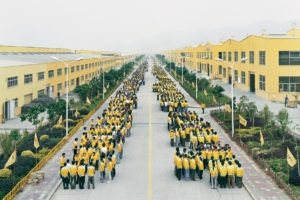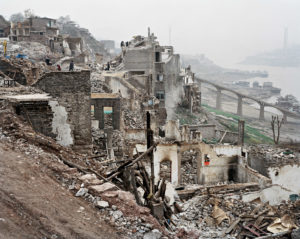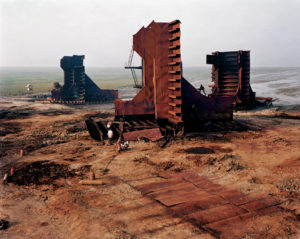Balancing Immersion with Making Impact in ‘Manufactured Landscapes’
In the 2006 documentary ‘Manufactured Landscapes’, director Jennifer Biachwal uses Edward Burtynsky’s photographs depicting rapid industrialisation to create a provocative window into the volume of waste and destruction associated with the entrenchment of global consumer capitalism. The film incites a visceral, emotional reaction in the spectator which seeks to make visible the brutal intensity of industrialisation in the developing world. The film predominantly achieves this through its style using lingering photographs to slow the pace and force the audience to consider imagery without much guidance. It is undoubtedly very effective at producing a consciousness raising response and independent thought on the part of the viewer. However, there are limitations on how effective this approach is, including photographs being too focused on being art and not sufficiently on what the small target audience can do with the information provided.
‘Manufactured Landscapes’ combines photographs that linger on screen with footage of Burtynsky on sites around the developing world emphasising visual communication with the viewer. The stills force the audience to really take in the contents of the image as well as slowing the pace of the film. They have more time to experience the image and become totally immersed, absorbing details that may have been lost in the expediency of a moving image. Looking at these photographs is almost akin to looking at a painting in an art gallery. Image 1 illustrates how much Burtynsky is focused on precision, framing and symmetry creating very visually exquisite and engaging art. This immersive capacity represents a strength compelling the spectator to really reflect on the content of the frame, and by extension the exploitation of workers and the natural environment portrayed.

Image 1: Factory workers are neatly arranged, colour coordinated showing a clear desire not only to document but to aestheticize the image.
Another element which contributes to the film’s immersive quality is its capacity to depict scale. It combines the large scale of buildings and landscapes with the small scale reflected in portraits and narratives of the people who live within these settings. This provides both a sense of the huge physical impact on the landscape and the personal impact on individual’s lives. Burtynsky photographs an entire city being torn down to make way for the construction of the Three Gorges Dam in China (image 2). This is contrasted with focusing on a portrait of a woman who disassembles electronics to reclaim the valuable metal in our waste, shipped in from across the world to be recycled (image 3). Biachwal pulls these elements together to provide a more complete picture of the process of industrialisation in a way that shocks and emotionally affects the viewer, pushing them to consider and digest how their consumption has an impact. This approach somewhat evokes Keenan’s logic that ‘‘if mass violations become known, the world reacts”[1]. ‘Manufactured Landscapes’ manages to make the “mass violations” known but puts responsibility for what form that reaction takes in the hands of the spectator[2]. It motivates the audience to define how to combat the exploitation of the environment and people during the process of industrialisation. These stylistic elements contribute to the film’s self-defined goal of trying “to shift our consciousness about the world”[3] but privilege the individual viewer’s thought process and own conclusions over defining any specific course of action. This arguably lessens the documentary’s overall power to make change.

Image 2: A city being disassembled and depopulated to make way for the Three Gorges Damn, showing the scale and reach of industrialisation.

Image 3: A woman in rural China sorts through pieces of discarded electronics searching for valuable metal components to be repurposed and recycled.
The aestheticizing of these images poses several obstacles to creating impact. Specifically, the pacing of the film and the context in which it is shown significantly limit its audience, and therefore its potential influence. Cammear draws connections between Burtynsky’s photographs and “fine art”[4] and the documentary very much appeals to an art house audience who appreciate this kind of high art, as illustrated by the way in which watching the film is reminiscent of being at an art gallery. The slow pace also contributes to this impression meaning for a broad mainstream audience it is likely to feel slow and inaccessible. Mostly circulating in art house film festivals like Sundance the film is aimed at and impacts a narrow audience.[5] Abrash and Whiteman describe the importance of a diverse community appeal and creating wider engagement in filmmaking through practices such as “community screenings, designed to spark discussion and stimulate action”.[6] ‘Manufactured Landscapes’ has limited audience and context in which it was screened and little community involvement. It certainly sparks discussion but does not stimulate specific action. This lack of broad engagement significantly curtails its capacity to spread awareness of the destructive side of industrialisation as intended, impacting only a niche audience.
Baichwal’s approach to making the less visible impacts of industrialisation seen relies heavily on Burtynsky’s bold and powerful images to rouse viewers into drawing their own conclusions. This is could be seen as one of the film’s strengths, avoiding patronising the viewer or force-feeding them an agenda. However, the beauty of these images, often of poverty and exploitation, makes for very uncomfortable viewing. The spectator almost enjoys looking at something so destructive presented so beautifully. The contrast of the chaos of waste with the skilled composition of the image creates what Cammear describes as a “conflicting experience”[7]. A sequence in Bangladesh where workers are paid nominal wages to carry out the dangerous work of ‘ship breaking’ is both visually stunning and deeply harrowing (image 4). This represents a duality about this film that tries to balance a deliberately highly immersive set of images with avoiding becoming too prescriptive. Nevertheless, in practice it prioritises art over making a change. The aestheticizing of the film undermines the impact it can make, leaving viewers feeling helpless with no instruction.

Image 4: The conflict of art and activism is illustrated here by ‘ship breakers’ operating highly dangerous circumstances but captured beautifully in Bangladesh.
‘Manufactured Landscapes’ seeks to make change by provoking critical independent thought and awareness of the brutality of industrialisation. The fact that the film is not prescriptive is both a strength and a weakness in terms of its impact. It provokes viewers to reflect but only in the limited sphere of art house film goers and doesn’t advocate specific action. There is a hopelessness in this lack of direction that means while it is a very emotionally affecting film, it lacks the capacity to really create change with no defined avenues for concerned viewers to enact their activism.
Watch the trailer for ‘Manufactured Landscapes’ here.
Visit Burtynsy’s Website discussing ‘Manufactured Landscapes’ here.
[1] Thomas Keenan, “Mobilizing Shame”, The South Atlantic Quarterly, Volume 103, (2004): 438.
[2] Ibid.
[3] “Manufactured Landscapes”, Edward Burtynsky, Accessed November 8 2018, https://www.edwardburtynsky.com/projects/films/manufactured-landscapes/
[4] Gerda Cammaer, “Edward Burtynsky’s Manufactured Landscapes: The Ethics and Aesthetics of Creating Moving Still Images and Stilling Moving Images of Ecological Disasters”, Environmental Communication, 3:1 (2009): 122.
[5] “Manufactured Landscapes”, Burtynsky.
[6] Barbara Abrash, David Whiteman, “The Uprising of ’34 : Filmmaking as Community Engagement”, Wide Angle 21, no. 2 (1999): 88.
[7] Cammaer, “Burtynsky’s Manufactured Landscapes”, 122.
